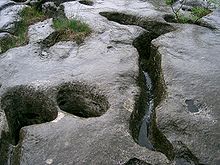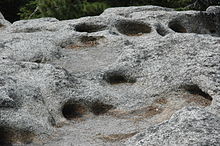- Panhole
-
A panhole is a depressed, erosional feature found on flat or gently sloping rock. Panholes are the result of long-term weathering and are generally seen on bedrock or very large blocks of rock. Similar terms are gnamma (Australia), opferkessel (German, roughly “sacrificial basin”), “armchair hollows”, weathering pans (or pits) and solution pans (or pits). Other German names include kamenitza and kamenica. In Spanish they are tinajita.
In Namaqualand these features are called !gau[1]
These shallow solution basins, or closed depressions, tend to form on bare limestone or silicate rock. They are also found on granitic rock. They are generally characterized by flat bottoms and sometimes by overhanging sides. The initial form may be a closed hollow created by a patch of humus. Diameters are rarely greater than 15 centimetersIn the Sierra Nevada, California these features were termed weathering pits[2] by Francois E. Matthes, where they are thought to indicate rock surfaces that are unglaciated or escaped more recent glaciations. In Sierra Nevada granitic rocks, these features have a characteristic shape such that they expand more rapidly in width than they grow in depth. [3] One explanation for their conformation is because the most active environment for weathering is the zone of alternate wetting and drying along the margins of the pools that collect in the pits, the margins tend to deepen and enlarge until all points of the bottom are equally wet or dry at the same time, thus producing their characteristic shape. [4]
The Australian aboriginal term gnamma, in particular, implies a depression capable of holding water at times.
A related concept is a "swirlhole": A hole in rock in a streambed eroded by eddying water, with or without sand or pebble abrasives. Swirlholes typically form at the bottoms of waterfalls.
Locations where panholes may be seen
- Beam Rocks, Forbes State Forest, Pennsylvania, USA
- Shenandoah National Park, Virginia, USA
- Glacier Point, Yosemite National Park, California, USA
References
- ^ "New species of ancient plant group discovered in South Africa". Royal Botanic Gardens, Kew. May 8, 2009. http://www.kew.org/about-kew/press-media/press-releases-kew/new-species-south-africa/index.htm. Retrieved 27 October 2010.
- ^ Matthes, Francois E. 1930. Geologic History of the Yosemite Valley. U.S. Geological Survey Professional Paper 160
- ^ Huber, N. King. 1989. The geological story of Yosemite National Park. U.S. Geological Survey Bulletin 1595.
- ^ Clyde Warhaftig, attributed on page p. 63 in Huber, N. King. 1989. The geological story of Yosemite National Park. U.S. Geological Survey Bulletin 1595.
Categories:- Geomorphology
- Geological processes
- Structural geology
- Geology stubs
Wikimedia Foundation. 2010.


